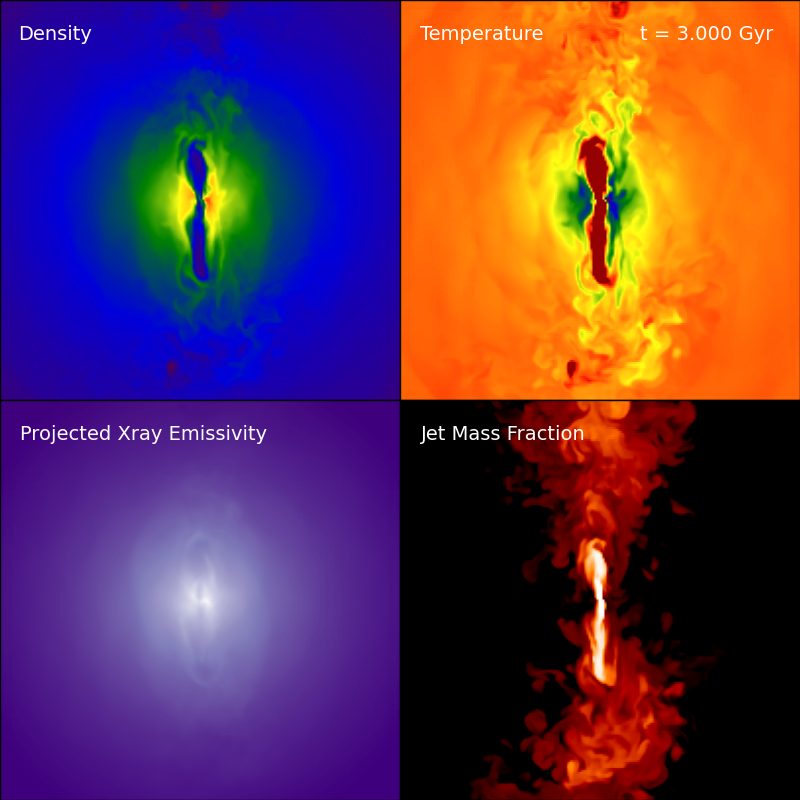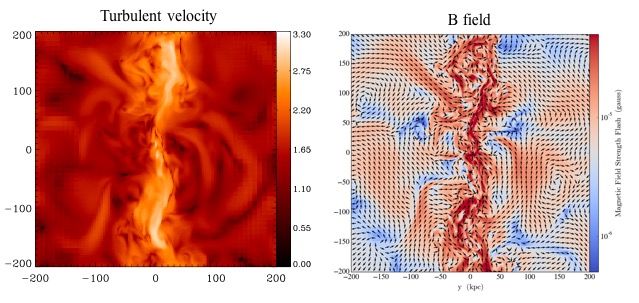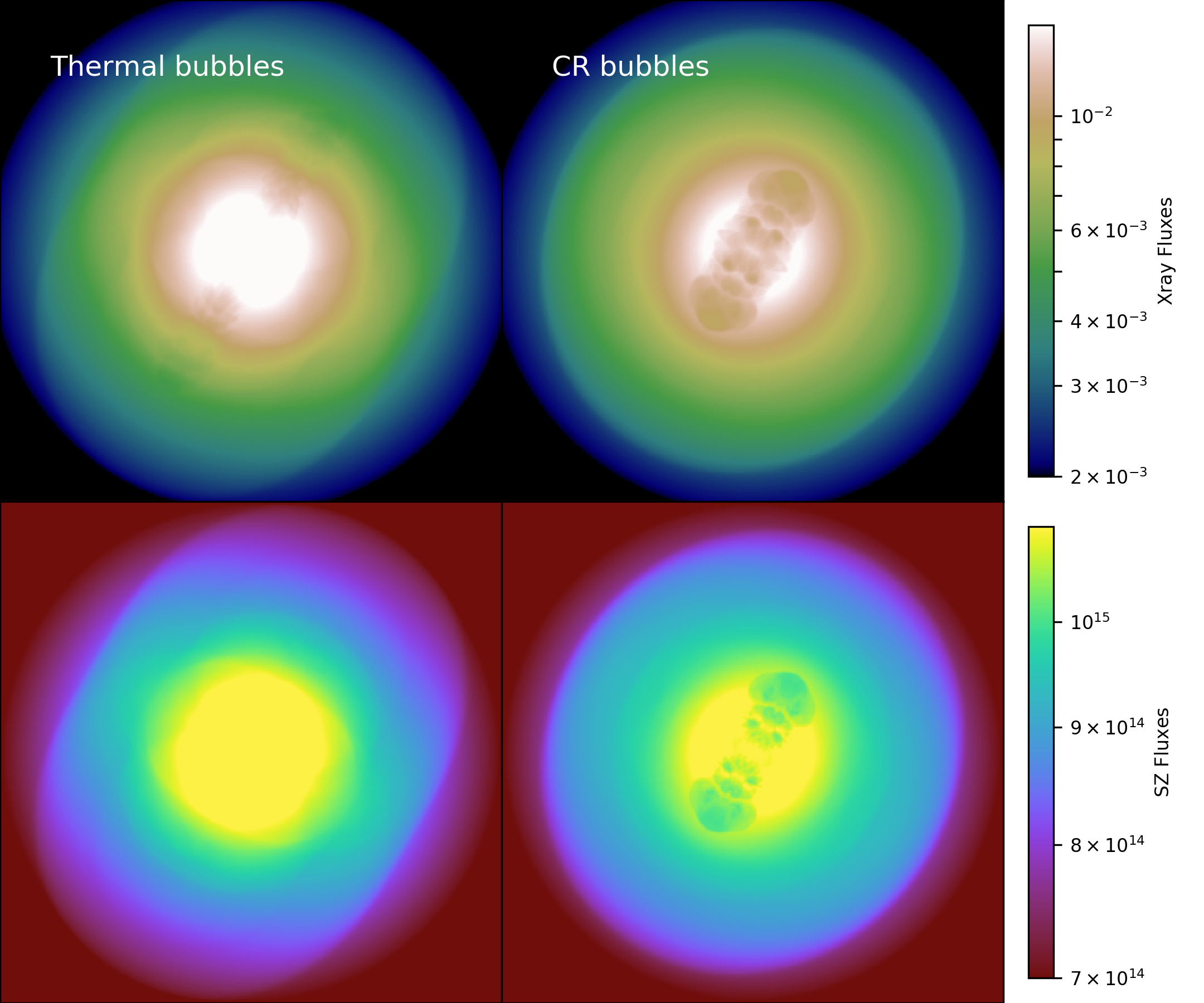Research
Our central research question is how the combined effects of shocks, turbulence, radiative cooling, active galactic nucleus (AGN) feedback, magnetic fields, cosmic rays (CRs), and plasma physics influence the observable properties of galaxies and galaxy clusters. The last few years have been marked by significant progress in galaxy and cluster formation, in which feedback processes from AGN and galactic winds (GWs) are believed to be critical ingredients. However, our current knowledge is largely limited by incomplete understanding of the "microphysics" -- fundamental physical processes that are unresolvable or missing from purely hydrodynamic simulations (including magnetic field, thermal conduction, viscosity, and CRs). Therefore, our group focuses on investigating these important but poorly understood microphysical mechanisms and how they impact the macroscopic properties of galaxies and clusters.
Find out more on each of the following topic:
Supermassive black hole jets in galaxy clusters
Relativistic jets from supermassive black holes (SMBHs) are one of the most powerful phenomena in the universe, even affecting their host galaxies and galaxy clusters. Clusters with short central radiative cooling times, or cool-core (CC) clusters, are expected to have cooling catastrophe and produce a lot of cold gas and stars near the cluster center. However, the observed star formation rate is typically 1-2 orders of magnitudes smaller than the predicted value (the so-called "cooling-flow problem." Feedback from the central AGN is believed to be the solution by providing heat to the intracluster medium (ICM) and counteract radiative cooling. However, the exact mechanism of how the jet energy is transformed into heat in the ICM remains uncertain.

In order to investigate the relative importance of various heating mechanisms, our group performed 3D hydrodynamic simulations of self-regulated AGN feedback in a Perseus-like cluster (see right figure). By tracking the thermodynamic histories of passively evolving tracer particles, we find that the increase in entropy of the gas (aka heating) primarily results from weak shocks and direct mixing between the ICM and the ultrahot thermal gas contained within the AGN jet-inflated bubbles, while turbulent heating is subdominant. Another long-standing question of AGN feedback is how the directional jets distribute heat to the entire cool core. By analyzing the trajectories of the tracer particles, we find that the gas within the cluster cores is undergoing a process of "gentle circulation" over billions of years. The gentle circulation could distribute and compensate the heat provided by the AGN jets without fine tuning [Yang & Reynolds 2016b].
[Click here to see a movie of the simulation]
[Click here to see the evolution of the tracer particles showing the gentle circulation]

Heating by thermal conduction from cluster outskirts has also been proposed as one promising heating mechanism. However, the ICM is magnetized, and conduction should be anisotropic along magnetic field lines. It is shown that anisotropic conduction within CCs would induce heat-flux driven buoyancy instabilities (HBI), which would re-oriente field lines in the azimuthal direction and shut off heat conduction. We performed the first 3D magnetohydrodynamic (MHD) simulations including anisotropic conduction and AGN feedback to study the interplay among radiative cooling, anisotropic conduction, and AGN jets. We find that AGN-driven turbulence can effectively counteract the field-line wrapping effect of the HBI (see right figure), resuming conduction to 1/3 of the full Spitzer value (expected for a fully tangled magnetic field). Comparing the amount of heat provided by conduction and direct AGN heating, we find that conductive heating is always subdominant, contributing to only 10% of the radiative losses for Perseus-like clusters (and about 50% for the most massive clusters in the universe) [Yang & Reynolds 2016a].

Previous studies of AGN feedback have mostly used momentum-driven jets; however, the composition of AGN jets and bubbles is highly uncertain. Observations of AGN bubbles in clusters suggest that some bubbles could be dominated by non-radiating relativistic particles, or CR protons. In order to study whether the dynamics and heating of the ICM would be affected by the jet composition, we compared simulations of kinetic-energy-dominated jets versus CR-energy-dominated jets. We fine that CR jet-inflated bubbles tend to be "fatter", thus more capable of uplifting the ambient ICM. Moreover, while kinetic jets heat the ICM by direct mixing very efficiently, CR heating occurs on longer timescales by hadronic and Coulomb collisions between the CRs and the ICM. As a result, cold clumps tend to form during the inflation of CR-dominated bubbles [Yang et al. 2019]. The distinct evolution of the hot ICM and cold clumps caused by different jet composition has critical impacts on SMBH feeding and feedback, e.g., affecting the AGN intermittency [Ruszkowski et al. 2017b]. Therefore, it is important to determine the jet/bubble composition using observational data. For example, we showed that CR bubbles would show supression of the Sunyaev-Zel'dovich (SZ) flux similar to the X-ray cavities, whereas hot bubbles formed by kinetic jets do not show such deficits (see left figure). This effect will be observable using SZ instruments with exceptional resolution and sensitivity including ALMA, MUSTANG-2, NIKA2.
The ultimate goal of these studies is to have a comprehensive understanding of how AGN feedback works in galaxies and clusters, and construct a robust, physically-motivated subgrid model of AGN feedback to be used in cosmological simulations. Previous studies have shown that AGN feedback prescriptions are in fact one of the largest uncertainties in predicting observable properties of clusters [Yang et al. 2012a]. Therefore, understanding the fundamental physical mechanisms behind AGN feedback is critical for minizing the systematic uncertainties [Yang et al. 2009, Yang et al. 2010] and improving cosmological constraints derived using large cluster surveys including DES, SPT, Planck and eRosita.
Origin of the Fermi bubbles
Fermi bubbles, two giant gamma-ray bubbles 50 degrees above and below the Galactic center (GC), are among the most important discoveries of the Fermi Gamma-ray Space Telescope. Because of the promixity, spatially resolved, multi-messenger observations have provided unprecedented opportunities to study the origin of the bubbles. Many different theoretical models have been proposed to explain the bubble formation; however, it remains a challenge for the models to match all the observational data given the stringent observational constraints (see Yang et al. 2018, for a review).

Our group uses 3D MHD simulations self-consistently including effects of CRs (which are the source of the gamma-ray emission) to investigate the scenario in which the Fermi bubbles are generated by past jet activity of the SMBH at the GC. We find the set of parameters which can reproduce the observed morphology and X-ray arc feature of the Fermi bubbles (see left figure). Our results suggest that in order to inflate the bubbles, the central SMBH has to be active about 1.2 Myr ago for about 0.3 Myr, with an Eddington radio of about 30% (this estimate is uncertain though due to the unknown initial central density of the Galactic halo). In addition, we showed that the sharp edges of the bubbles could be explained by the combined effect of magnetic draping (alignment of magnetic field orientation with the bubble surface) and anisotropic CR diffusion along the field lines [Yang et al. 2012].

We further compared our simulation predictions to the multi-wavelength observational data, including the gamma-ray bubbles, microwave haze (Finkbeiner et al. 2004), and polarization properties (Carretti et al. 2013). We find that the leptonic (meaning that the gamma-ray emission is produced by CR electrons via inverse-Compton (IC) scattering of Galactic photons) AGN scenario is broadly consistent with the data. In particular, the model is able to reproduce the spectra of the gamma-ray bubbles and the microwave haze simultaneously by the same population of CR electrons, which is a major difficulty for some of the other models (e.g., the hadronic models). In addition, the simulated polarization fraction within the bubbles is consistent with the data. We also find that both the polarization fractions and the rotation measure near the bubble surface should be enhanced due to the magnetic draping effect [Yang et al. 2013].
A unique feature of the Fermi bubbles is the spatially uniform gamma-ray spectrum. In particular, the gamma-ray spectrum is hard (with a spectral index of -2), with a latitude-independent exponential high-energy cutoff at about 150 GeV. The spatially uniform spectrum is nontrivial to reproduce because it requires correct distributions of the underlyting CRs both spatially and spectrally. We developed a new CRSPEC code in FLASH, which could model the CR spectral evolution on-the-fly during the MHD simulations. We follow the evolution of CR spectra injected by the AGN jets and self-consistently account for CR energy losses due to IC and synchrotron radiation. The simulated spectrum for the Fermi bubbles has remarkable agreement with the data, including the amplitudes, overall shapes, high-energy cutoff, and its spatial uniformity (see left figure). We find that the high-energy cutoff could be a signature of CR electron cooling near the GC. Once the jets leave the Galactic plane, the dynamical time of the jets become the shortest among all timescales, and therefore the spectrum is preserved toward larger distances. This could explain why the bubble spectrum is so spatially uniform, analogous to the idea of inflation in the early universe because everything was in causal contact with each other before inflation started [Yang & Ruszkowski 2017].
Starburst driven galactic winds
Galactic winds (GWs) are ubiquitous and play an essential role in the formation and evolution of galaxies. However, understanding of the physical mechanisms driving them is still incomplete. Recent studies have emerged that CR-driven winds are the most promising mechanism for wind-launching. In particular, recent 3D simulations have consistently found winds of mass-loading factor around 1 can be driven, because CRs (accelerated in supernova explosions) can diffuse or stream outside the disks and accelerate the more tenuous gas in the shallower potential well. Therefore, CR-driven winds have become a young and fast-growing topic in the galaxy-formation community.

Our group performed the first 3D MHD simulations of galactic winds including the effects of CR streaming (which is a specific description of how CRs couple to the thermal gas, including their relative velocity shifts and energy transfer). We showed that large-scale galactic winds can be driven only when CR streaming is included (see bottom row in left figure), whereas no wind is found in the simulation without streaming (top row). In addition, the wind properties and star formation rate at the end of the simulations critically depend on the streaming speed (which is determined by interactions between CRs and the thermal gas on microphysical scales, i.e., the "microphysics"). Our results indicate that understanding the details of microphysics is important for predicting the macroscopic properties of winds, galaxies, and the circumgalactic medium [Ruszkowski et al. 2017a].

Therefore, we continue to explore the detailed interactions between CRs and gas using high-resolution simulations of galactic-disk patches. First, we studied the effect of decoupling (which refers to the fact that CRs couple very weakly with the gas within cold, neutral clouds in the interstellar medium due to ion-neutral frictions) on the properties of the winds [Farber et al. 2018]. We find that the wind properties can be affected by the decoupling effect. While winds driven by typical CR diffusion prescriptions are denser and colder, winds in the decoupling case tend to be less dense and hotter (see top row of right figure). More recently, we explored how the wind properties can be affected by spatially-dependent CR streaming speeds determined by turbulent damping (i.e., CRs would stream faster when Alfven waves are damped by turbulence). In this work, we showed that the CR streaming speed can be boosted by a factor of 2-3 beyond the Alfven speed due to turbulence close to the galactic disk. With the enhanced streaming speed, the CRs travel further away from the disk and more easily lift the gas at larger heights. This results in more extended CR and gas distributions for the simulation including turbulent damping. This paper has just been published recently. Feel free to check it out! [Holguin et al. 2019].